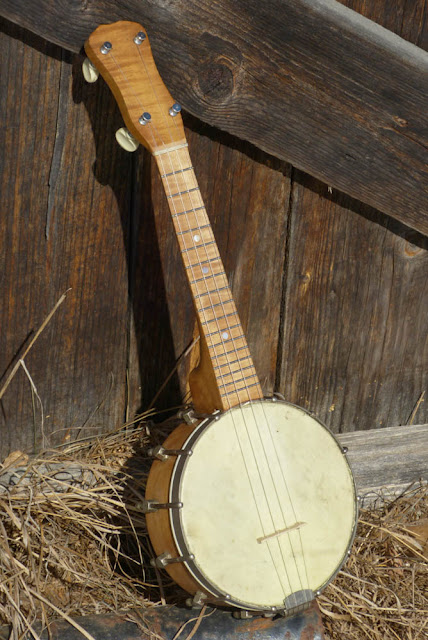1930s Slingerland-style Banjo Ukulele
I've worked on a lot of this particular Chicago-made banjo uke model and it comes in a variety of names including Concertone, Slingerland, Slingerland's "May Bell" moniker, and others. This one happens to be unbranded and probably dates from the late 1920s to early 1930s. It's made entirely from maple, has a quite-flamed neck, and the shorter 13" scale length that puts its bridge in a sweeter spot vs. the 14" scale versions. The tone is loud and choppy and the hoop tonering gives it a bit of bite and ring.
My work was actually pretty nuts: this got a new skin head (recycled from a bigger 1920s banjo head), one period replacement hook/nut, new maple bridge, replacement older (1970s? 80s?) pegs, and a fretboard plane/refret. The neck had a weird twist/warp in it to begin with so it was necessary. The result, however, means that this instrument plays and handles like a brand new high-brow banjo uke with good, modern-sized frets and perfect 1/16" action at the 12th fret.
This banjo uke has the standard 7" multi-ply maple rim of the period with maple veneer on the inner and outer edges. All the rim hardware is original save one period hook/nut from my parts-bin.
The maple neck has a ton of figure in it and looks great. The nut is new and bone and the strings are fluorocarbon.
The friction pegs work swell. I replaced the original ones as several were bent and damaged and the knobs were a bit warped.
Originally this would've had a friction-set shim-style neck brace that hammered into the dowel. I replaced that with a single screw into the heel. This is more than enough security and stability and functions far better than the shim-style brace. No fuss.
Note the bit of foam stuffed under the dowel -- this cuts down on overtone ring that's a near-constant on any banjo uke with a tonering installed. I like the way it mellows the sound but it's not necessary at all.
Note the bit of foam stuffed under the dowel -- this cuts down on overtone ring that's a near-constant on any banjo uke with a tonering installed. I like the way it mellows the sound but it's not necessary at all.
The tailpiece has to be angled over a little to align with the neck -- this is par for the course with old banjos of any stripe.
Note my replacement maple bridge: this is as close as it gets to the all-maple bridges that were often installed on these from the factory. It's just a little lower than 1/2" in height.













Comments